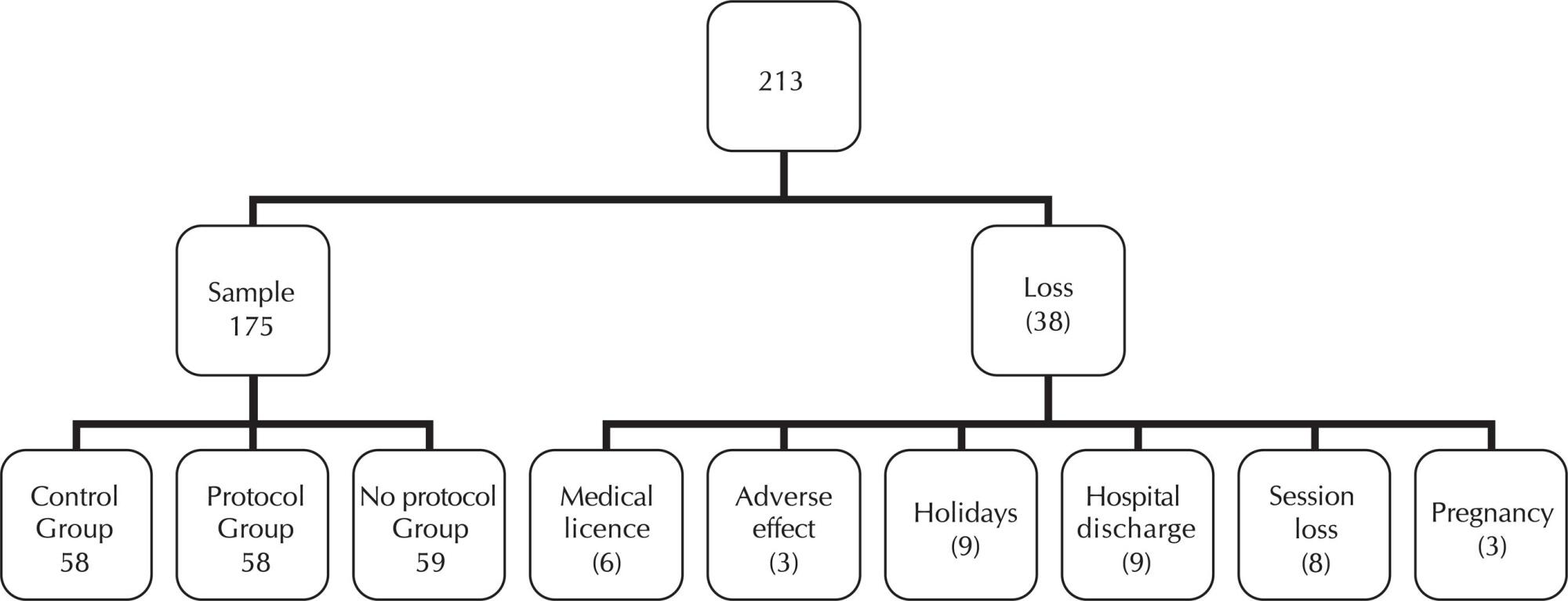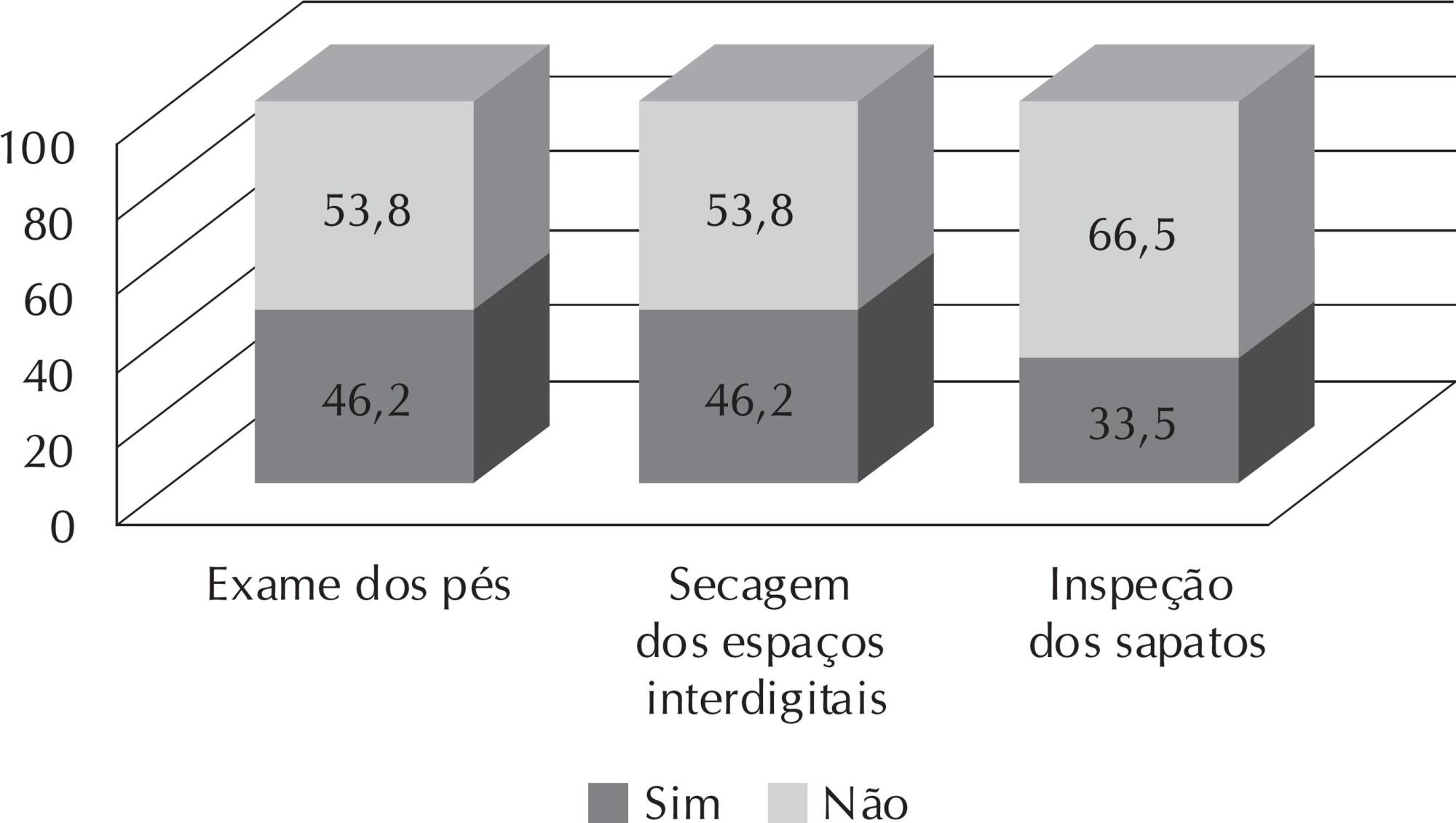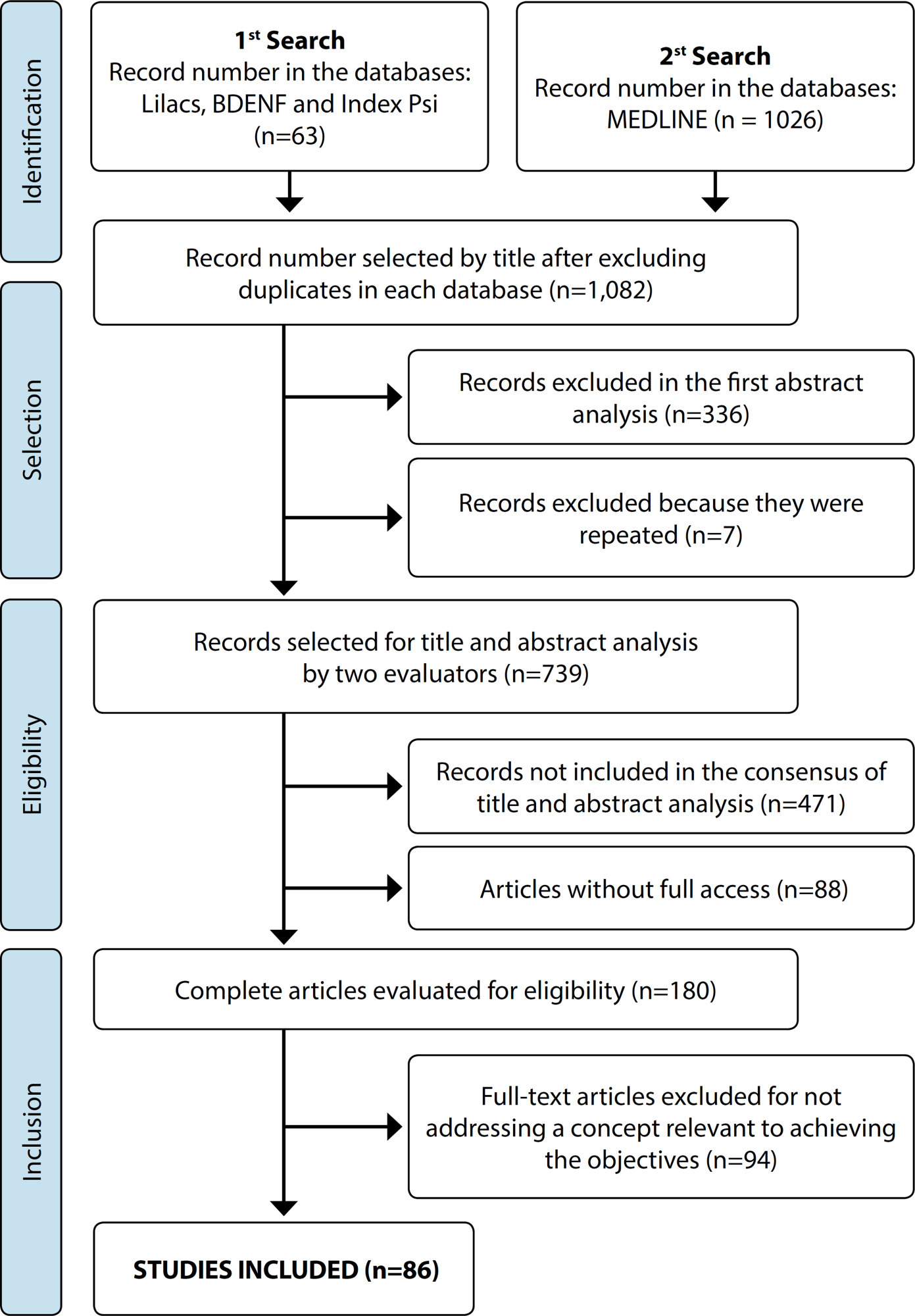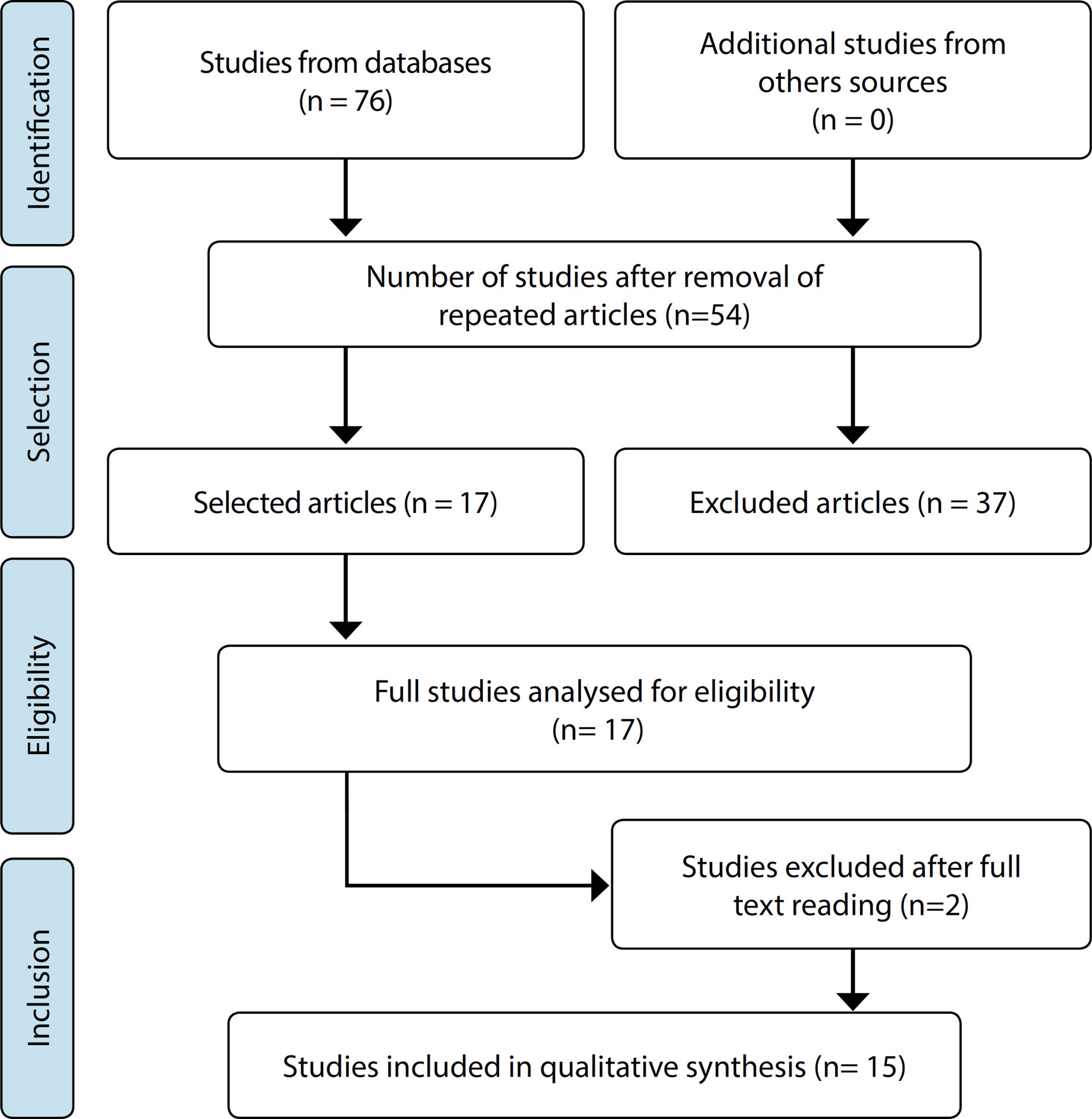-
REVIEW
Staphylococcus aureus meticilino resistente adquirido na comunidade: um problema mundial
Revista Brasileira de Enfermagem. 2015;68(1):136-143
01-01-2015
Abstract
REVIEWStaphylococcus aureus meticilino resistente adquirido na comunidade: um problema mundial
Revista Brasileira de Enfermagem. 2015;68(1):136-143
01-01-2015DOI 10.1590/0034-7167.2015680119p
Views0Objetivo:
descrever a epidemiologia dos casos de CA-MRSA no Brasil de forma a compreender sua ocorrência, fatores de risco associados e formas de manejo em relação à situação mundial.
Método:
revisão integrativa e para seleção dos estudos utilizou-se as bases de dados: Scopus, Science direct, Isi Web of Knowledge, PUBMED e BVS.
Resultados:
foram identificados dez artigos nacionais que descreveram 21 casos de CA-MRSA principalmente em crianças, adolescentes e adultos com quadro de infecção de pele e tecidos moles evoluindo para infecções graves relacionados ao clone Oceania Southwest Pacific Clone (OSPC) que resultaram em hospitalização.
Conclusão:
apesar do CA-MRSA ser considerado um micro-organismo de relevância mundial verificou-se a escassez de dados publicados sobre sua epidemiologia no Brasil, o que dificultam o delineamento da realidade do país frente ao CA-MRSA.
Keywords:Controle de InfecçõesFarmacorresistência BacterianaInfecções Comunitárias AdquiridasStaphylococcus Aureus Resistente à MeticilinaSee more -
REVIEW
Prevention and non-pharmacological management of pain in newborns
Revista Brasileira de Enfermagem. 2015;68(1):131-135
01-01-2015
Abstract
REVIEWPrevention and non-pharmacological management of pain in newborns
Revista Brasileira de Enfermagem. 2015;68(1):131-135
01-01-2015DOI 10.1590/0034-7167.2015680118i
Views0See moreObjective:
to describe the main non-pharmacological interventions for pain relief in newborns available in Neonatal Intensive Care Unit.
Method:
an exploratory search of the MedLine, Lilacs and Scielo online databases was conducted to retrieve references of studies published from 2004 to 2013.
Results:
several non-pharmacological interventions were shown to be effective, to represent low risk for neonates and to have a low operational cost. The ones most often discussed in the literature were: oral administration of glucose/sucrose, non-nutritive sucking, breastfeeding, skin-to-skin contact, facilitated tucking and swaddling.
Conclusion:
healthcare teams should be familiar with these methods and use them more effectively in Neonatal Intensive Care Unit daily routines, so as to ensure that newborns receive qualified and more human care.
-
BANFISA e (IN)DICA-SUS na graduação em saúde: o lúdico e a construção de aprendizados
Revista Brasileira de Enfermagem. 2015;68(1):124-130
01-01-2015
Abstract
BANFISA e (IN)DICA-SUS na graduação em saúde: o lúdico e a construção de aprendizados
Revista Brasileira de Enfermagem. 2015;68(1):124-130
01-01-2015DOI 10.1590/0034-7167.2015680117i
Views0See moreObjectives:
to analyze the learning built during the matches of the games by students of the subject Gestão de Políticas Públicas em Saúde at the Universidade de Brasília.
Method:
exploratory, descriptive research, in a qualitative approach, with 26 students from various graduation courses in health, using a questionnaire and participant observation.
Results:
participants reinvented rules, related issues addressed in the games to the reality, interacted with colleagues and had fun throughout the match. Comparing the games in relation to ludicity, the BANFISA was more attractive than the (IN) DICA-SUS, although they are complementary.
Conclusions:
learning constructed by the students goes beyond the content of the subject; involve the active participation in group and creativity.
-
Chinese auriculotherapy to improve quality of life of nursing team
Revista Brasileira de Enfermagem. 2015;68(1):117-123
01-01-2015
Abstract
Chinese auriculotherapy to improve quality of life of nursing team
Revista Brasileira de Enfermagem. 2015;68(1):117-123
01-01-2015DOI 10.1590/0034-7167.2015680116p
Views0See moreObjective:
to evaluated the effi cacy of auriculotherapy for improving quality of life and reducing stress in nursing staff.
Method:
single-blind radomizad clinical trail envolving 175 subjects randomized in: Control (G1), Protocol Group (G2) and without Protocol Group (G3). They were evaluated by the Stress Symptoms List and SF36v2 at baseline, after 12 sessions and follow up (30 days), between January and July 2012.
Results:
both intervention groups reduced stress (p <0.05) with greater effect for G3 (d = 1.15). G3 was also higher for improving life quality especially the physical domain (p = 0.05).
Conclusion:
individualized auriculotherapy (G3) had greater effect compared to the protocol auriculotherapy (G2) for reducing stress and improving life quality.

-
Adherence to foot self-care in diabetes mellitus patients
Revista Brasileira de Enfermagem. 2015;68(1):111-116
01-01-2015
Abstract
Adherence to foot self-care in diabetes mellitus patients
Revista Brasileira de Enfermagem. 2015;68(1):111-116
01-01-2015DOI 10.1590/0034-7167.2015680115p
Views0See moreObjective:
to analyze the self-care of patients with type 2 diabetes mellitus in the Family Health Strategy in Teresina-PI.
Method:
search cross selected by simple random sampling, 331 people with diabetes mellitus. Data collection took place from August to December 2012 with the use of Self-Care Activities Questionnaire with Diabetes and structured instrument for recording information socioeconomic and guidance received by the professional nurse.
Results:
the data revealed that patients have poor adherence to blood glucose monitoring, the physical exercise and foot care, but with good adherence to the medication. Only 38.7% of the sample examined the feet of fi ve to seven days a week. Statistically signifi cant association between self-care activities with their feet and orientations of nurses (p < 0,05).
Conclusion:
that there is need to raise awareness with regard to the development of skills for self-care.

-
Patients with disorders of consciousness: vital, facial and muscular responses to music or messages
Revista Brasileira de Enfermagem. 2015;68(1):102-110
01-01-2015
Abstract
Patients with disorders of consciousness: vital, facial and muscular responses to music or messages
Revista Brasileira de Enfermagem. 2015;68(1):102-110
01-01-2015DOI 10.1590/0034-7167.2015680114p
Views0See morePurposes:
to compare vital signs, facial expression and basal electroneurographic signs with measures during stimuli music, message or “silence” in coma patients, vegetative status or sedated; and relating the score of Glasgow Results Scale with the intervention realized.
Method:
a Monoblind Transversal Controlled Clinical Trial to researcher. The distribution, among the three groups, was randomized (experiment with music, experiment with message or control). Two assessments (sessions) were performed with interval of 40 minutes on the same day.
Results:
most of the 76 patients were male, between 18 to 36 years old and hospitalized due to trauma. Statistically signifi cant changes were found in the variables referred to temperature, facial expression, electroneurography and Glasgow Results Scale; more frequent alterations in second session, in coma and vegetative patients, in frontal muscles and in experiment group.
Conclusions:
the facial expression and the electroneurography seem to be more trustworthy variables than vital signs to evaluate consciousness.
-
Prevalence of minor psychiatric disorders in socio-educational agents in the state of Rio Grande do Sul
Revista Brasileira de Enfermagem. 2015;68(1):93-101
01-01-2015
Abstract
Prevalence of minor psychiatric disorders in socio-educational agents in the state of Rio Grande do Sul
Revista Brasileira de Enfermagem. 2015;68(1):93-101
01-01-2015DOI 10.1590/0034-7167.2015680113p
Views0See moreObjective:
to determine the prevalence and factors associated with minor psychiatric disorders (MPD) in socio-educational agents.
Method:
it is a cross-sectional study with 381 socio-educational agents the Centers for Socio-Educational Services in the State of Rio Grande do Sul, Brazil. The Brazilian versions of the Scale of Demand-control-social support at work and the Self Reporting Questionnaire-20 have been applied.
Results:
the results showed a prevalence of suspicion MPD of 50.1%. They showed to be related to suspicion of MPD : being female (55.7%), having age up to 44 years old (58.5%), no physical activity (57.4%), do not have time for leisure (75%), make use of medication (61.4%), require medical attention (56.9%) and psychological counseling (72.7%), not being satisfied with the workplace (61.7%) and need for time off from work (65.6%).
Conclusion:
the study provides important data about the mental health of agents, showing the need for the involvement of managers and of the health service of worker’s health in planning actions to promote health of these workers.
-
Factors associated with immunization against Hepatitis B among workers of the Family Health Strategy Program
Revista Brasileira de Enfermagem. 2015;68(1):84-92
01-01-2015
Abstract
Factors associated with immunization against Hepatitis B among workers of the Family Health Strategy Program
Revista Brasileira de Enfermagem. 2015;68(1):84-92
01-01-2015DOI 10.1590/0034-7167.2015680112p
Views0See moreObjective:
to investigate the report of vaccination against Hepatitis B, verification of immunization and the factors associated with dosages of anti-HBs.
Method:
we collected blood samples from those reported that they had one or more doses of the vaccine. We evaluated the association of the dosage of anti- HBs with sociodemographic conditions, occupational and behavioral. The associations were verified by Mann Whitney and Kruskal Wallis and correlation Spermann by linear regression using SPSS® 17.0.
Results:
among the 761 respondents, 504 (66.1%) were vaccinated, 52.5 % received three doses, 30.4 % verified immunization. Of the 397 evaluated for the determination of anti-Hbs, 16.4% were immune.
Conclusion:
it was found that longer duration of work was associated with higher levels of anti-HBs, while levels of smoking were inversely associated with anti-HBs. These workers need for vaccination campaigns.
-
ORIGINAL ARTICLE
Culture of patient safety in hospital units of gynecology and obstetrics: a cross-sectional study
Revista Brasileira de Enfermagem. 2020;73(5):e20190576
07-13-2020
Abstract
ORIGINAL ARTICLECulture of patient safety in hospital units of gynecology and obstetrics: a cross-sectional study
Revista Brasileira de Enfermagem. 2020;73(5):e20190576
07-13-2020DOI 10.1590/0034-7167-2019-0576
Views0ABSTRACT
Objectives:
to assess the patient safety culture of the health team working in three maternity hospitals.
Methods:
observational, cross-sectional, comparative study. 301 professionals participated in the study. The Hospital Survey on Patient Safety Culture questionnaire validated in Brazil was used. For data analysis, it was considered a strong area in the patient safety culture when positive responses reached over 75%; and areas that need improvement when positive responses have reached less than 50%. To compare the results, standard deviation and thumb rule were used.
Results:
of the 12 dimensions of patient safety culture, none obtained a score above 75%, with nine dimensions scoring between 19% and 43% and three dimensions between 55% and 57%.
Conclusions:
no strong dimensions for safety culture were identified in the three maternity hospitals. It is believed that these results may contribute to the development of policies that promote a culture of safety in institutions.
Keywords:Cross-Sectional StudiesHospital Gynecology and Obstetrics UnitOrganizational CulturePatient Care TeamPatient SafetySee more -
ORIGINAL ARTICLE
Incontinence associated dermatitis in elderly people admitted to a university hospital
Revista Brasileira de Enfermagem. 2020;73:e20190374
09-21-2020
Abstract
ORIGINAL ARTICLEIncontinence associated dermatitis in elderly people admitted to a university hospital
Revista Brasileira de Enfermagem. 2020;73:e20190374
09-21-2020DOI 10.1590/0034-7167-2019-0374
Views0See moreABSTRACT
Objective:
To identify the frequency and factors associated to incontinence associated dermatitis in elderly people.
Methods:
Cross-sectional study with 202 elderly patients admitted to a university hospital between September 2017 and January 2018. Data collection included: cognitive screening, sociodemographic and clinical questionnaire. It was performed exploratory and descriptive analysis, where prevalence and ratios (PR) were calculated.
Results:
Prevalence of injury was 9.4%, age range 70-79 years (13.5%), African American (21.4%), hospitalization period ≥ 21 days (44.4%), in use of nasogastric tube (33.3%), medical device (11.3%), restricted mobility (18.5%). It was associated with hospitalization period, use of nasogastric tube, restricted mobility, medical devices, and cognition.
Conclusion:
It was confirmed an average frequency of incontinence associated dermatitis in elderly patients and association to factors such as hospitalization period, immobility, cognition, use of nasogastric tube and devices. It must be highlighted the importance of prevention measures, early detection, assessment and monitoring of this type of injury.
-
ORIGINAL ARTICLE
Quality of life in the climacteric of nurses working in primary care
Revista Brasileira de Enfermagem. 2019;72:154-161
12-13-2019
Abstract
ORIGINAL ARTICLEQuality of life in the climacteric of nurses working in primary care
Revista Brasileira de Enfermagem. 2019;72:154-161
12-13-2019DOI 10.1590/0034-7167-2018-0306
Views0See moreABSTRACT
Objective:
to evaluate the quality of life of primary care nurses in the climacteric.
Method:
A cross-sectional descriptive-analytic study, performed with 98 female nurses, aged 40-65 years, using the WHOQOL-Bref questionnaire.
Results:
the worst level of quality of life was observed for professionals aged 50-59 years, non-white, specialists, divorced or widowed, with children, a lower income, with another employment relationship, a weekly workload of more than 40 hours, who consumed alcoholic beverages weekly, with chronic disease, in continuous use of medications, sedentary, who did not menstruate and did not receive hormonal treatment, and who went through menopause between the ages of 43-47 years.
Conclusion:
Although the variables “physical activity” and “age” have a statistically significant association with quality of life, other variables seem to interfere in these professionals’ lives, indicating the need for a more critical and deep reflection on these relations.
-
REVIEW
Scientific production about palliative care and communication in online journals: a scoping review
Revista Brasileira de Enfermagem. 2021;74(2):e20190378
05-28-2021
Abstract
REVIEWScientific production about palliative care and communication in online journals: a scoping review
Revista Brasileira de Enfermagem. 2021;74(2):e20190378
05-28-2021DOI 10.1590/0034-7167-2019-0378
Views0See moreABSTRACT
Objectives:
to characterize publications about palliative care and communication, with an emphasis on the approaches addressed, disseminated in online journals.
Methods:
it is a scope review, in which the mnemonic strategy Problem, Concept and Context was used, based on database research. The sample consisted of 86 publications.
Results:
most publications were written in the English language, published in the journal BMC Palliative Care, and with level of evidence IV. As for the approaches approached, the following stand out: Importance of communication in palliative care; Breaking the bad news in palliative care; Training professionals/staff to communicate in palliative care; and Communication strategies in palliative care.
Final Considerations:
the review made it possible to map a significant number of publications on palliative care and communication. It is recommended to produce new studies with better scientific evidence that guide the assistance of health professionals.

-
ORIGINAL ARTICLE
Perception of nursing workers on the care of hypertension in older adult
Revista Brasileira de Enfermagem. 2019;72:3-13
12-05-2019
Abstract
ORIGINAL ARTICLEPerception of nursing workers on the care of hypertension in older adult
Revista Brasileira de Enfermagem. 2019;72:3-13
12-05-2019DOI 10.1590/0034-7167-2016-0681
Views0ABSTRACT
Objective:
To understand how nursing workers perceive care of hypertension (HBP) in older adult within the scope of the Family Health Strategy.
Method:
A qualitative descriptive study carried out in the city of Natal/RN, with 20 nursing workers providing care to older adults with HBP. The data were obtained through a semi-structured interview and analysed by the Thematic Analysis, based on the theoretical support of the integrality, using Atlas.ti 7.0 software.
Results:
The elements found as facilitators were: territorialization, partnerships, professional proactivity and the user’s bond with the team. Among those found as barriers were: disease-centered care; academic education based on the biomedical model; lack of inter-sectorality and discontinuity of care in the care network.
Final considerations:
Nursing workers perceive that health institutions lack articulated and innovative practices that incorporate new paradigms focused on integrality of care.
Keywords:Chronic DiseaseDelivery of Health CareFamily Nurse PractitionersHealth Services for the AgedPrimary Health CareSee more -
EXPERIENCE REPORT
Generating meaningful conversation: World Café in strategic interprofessional planning in Continuing Education
Revista Brasileira de Enfermagem. 2020;73(5):e20190279
07-01-2020
Abstract
EXPERIENCE REPORTGenerating meaningful conversation: World Café in strategic interprofessional planning in Continuing Education
Revista Brasileira de Enfermagem. 2020;73(5):e20190279
07-01-2020DOI 10.1590/0034-7167-2019-0279
Views0ABSTRACT
Objectives:
to present the particularities of the World Café, identifying the main aspects that characterize a planning strategy for a constructive, interactive, and participative dialogue of the individuals, aiming at collaborative and innovative learning.
Methods:
a World Café method workshop with 24 professionals from the teams that work in basic health units.
Results:
we obtained three analysis categories: Individual Needs, Group Needs, and Institutional Needs, which resulted in the Municipal Plan of Actions on Continuing Health Education.
Conclusions:
we found that the World Café was adequate and relevant for the discussion of key themes, for the practices of teams in Primary Care and the production and organization of data in a collective space.
Final Considerations:
the method can contribute to the construction of knowledge and proximity to the daily reality of interdisciplinary teams, as well as serving as a tool in the preparation of planning in Permanent Education.
Keywords:Continuing EducationIntersectoral CollaborationMethodologyPrimary Health CareQualitative ResearchSee more -
ORIGINAL ARTICLE
Knowledge and practices of nursing professionals in caring for ostomates
Revista Brasileira de Enfermagem. 2020;73:e20200018
12-21-2020
Abstract
ORIGINAL ARTICLEKnowledge and practices of nursing professionals in caring for ostomates
Revista Brasileira de Enfermagem. 2020;73:e20200018
12-21-2020DOI 10.1590/0034-7167-2020-0018
Views0See moreABSTRACT
Objective:
to analyze the knowledge and practices of nursing professionals in caring for people with colostomy bag.
Method:
a qualitative and descriptive study conducted with 21 nursing professionals from a General Surgery Unit. Data collection used triangulation of techniques, based on non-participant observation, analysis of nursing records, and semi-structured interviews. Analysis followed the spiral technique assumptions.
Results:
it was possible to comprehend the theoretical and scientific knowledge that subsidize practice; identify contradictions related to statement and care in the profession’s daily work and the intervening factors, which can facilitate and/or make the nursing care process difficult.
Final Considerations:
knowledge and practices of professionals in caring for ostomates occur within work experiences, in which socialization of knowledge makes it possible to expand the perspectives of care.
-
REVIEW
Vertical transmission and COVID-19: a scoping review
Revista Brasileira de Enfermagem. 2021;74:e20200849
05-21-2021
Abstract
REVIEWVertical transmission and COVID-19: a scoping review
Revista Brasileira de Enfermagem. 2021;74:e20200849
05-21-2021DOI 10.1590/0034-7167-2020-0849
Views0ABSTRACT
Objective:
Analyze available evidence related to SARS-CoV-2 infection and vertical transmission.
Methods:
Scoping review, according to the Joanna Briggs Institute and PRISMA-ScR. Searches were conducted in five electronic databases to find publications about coronavirus infection and vertical transmission. Data were extracted, analyzed and synthesized by three independent researchers using a descriptive approach.
Results:
The search resulted in 76 publications. After selective steps, 15 articles – retrospective descriptive or case studies – were analyzed, all in English. In order to track the infection, specimens were collected from neonates through nasal swabs and C-reactive protein from breast milk, cord blood, amniotic fluid, placenta and vaginal secretion was analyzed. A small percentage of neonates tested positive for COVID-19, but these cases were not attributed to vertical transmission.
Conclusion:
Vertical transmission could not be demonstrated. Research protocol registered with the Open Science Framework (https://osf.io/fawmv).
Keywords:Coronavirus InfectionsInfant, NewbornInfectious Disease Transmission, VerticalObstetric NursingReviewSee more
Search
Search in:
Nuvem de Tags
Aged (144) Atenção Primária à Saúde (239) COVID-19 (104) Cuidados de Enfermagem (269) Educação em Enfermagem (151) Educação em Saúde (139) Enfermagem (930) Estudos de Validação (131) Health Education (144) Idoso (208) Mental Health (149) Nursing (987) Nursing Care (306) Patient Safety (151) Primary Health Care (284) Qualidade de Vida (104) Quality of Life (106) Saúde Mental (145) Segurança do Paciente (150) Validation Studies (108)



